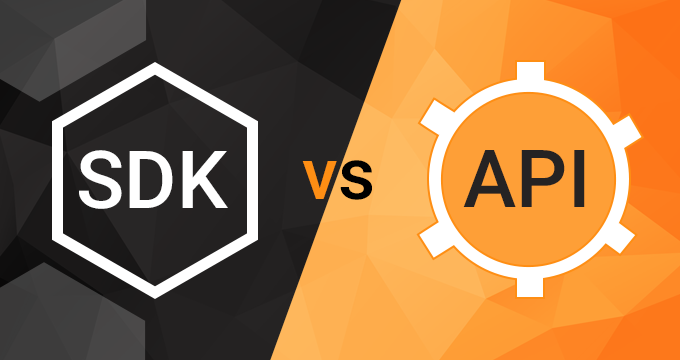What's the Difference Between SDK and API?

You may be wondering what’s the difference between an SDK and an API. The short answer is that they are used in different ways and for different purposes.
In this post, we discuss what is an SDK, and what is an API.
What is an SDK?
A Software Development Kit (SDK) provides a set of tools, libraries, documentation, code samples, processes, and guides typically for a specific platform. SDKs often present a set of APIs for developers to interface with, which can be used to create and develop applications. The applications call the interfaces to implement a functionality.
SDKs save developers a lot of time and headache by simplifying their work so they don’t have to start from scratch. Without an SDK, developers essentially need to reinvent the wheel.
What is an API?
When developing software applications that interact with other software that may use a completely different language, the two programs need to be able to communicate with each other. This is where APIs come in. It is an Application Program Interface, which is exactly what it sounds like. It provides an interface for two application programs to speak the same language.
Interface Between Two Programs
Take a personal computer as an example. An end-user may buy one brand of printer, another brand of scanner, and another type of camera. Then over time may replace each of these devices, or add new ones. The computer must be able to communicate and give instructions with each device. The API acts as a communication bridge, defining a communication protocol that allows the programs to communicate. This is the core of an API’s functionality.
In the early days of computer programming, commands and instructions were all over the place. There was no standards of practice, and instructions were rarely documented. What APIs have allowed is for a consistent and stable coding environment, ensuring functions are carried out the same way every time. This makes the computing experience reliable and predictable.
Web API
With the ubiquity of cloud and web, the term “API” sometimes specifically means Web APIs, such as representational state transfer (REST) style APIs and resource-oriented architecture (ROA) style APIs. An API defines a communication protocol that allows you to programmatically access a third-party service or product. You can make requests, such as Hypertext Transfer Protocol (HTTP) request messages, and receive responses to and from the third party, as well as manage objects. The returned responses are of defined structure, usually in an Extensible Markup Language (XML) or JavaScript Object Notation (JSON) format.
SDK vs API
What may be confusing to some is that SDKs typically contain APIs. As mentioned, an SDK is a tool kit that, among other things, includes instructions that allow developers to create applications. Naturally, when a developer uses an SDK, it needs to be able to communicate with other applications. As such, an API is used for this functionality. However, the distinction lies in the fact that while an API is used for communication, it cannot be used solely to create an application.
In the context of web development, SDK and API are suitable for different use cases:
- Web APIs are typically light-weighted and serve specific purposes. SDKs can be heavier and comprehensive.
- With Web APIs, it’s easy to update. In many cases, the API users don’t need to update their code to take advantage of the improved APIs. With SDKs, the users typically need to download the improvements to their local environment and rebuild their app.
- The SDK works better for users who are using a programming language the SDK supports; and whose app needs to work standalone without a network. The Web API works better for users who wants a quicker implementation; and the barcode recognition plays a small part in their app.
Dynamsoft SDKs
Some of the largest companies in the world run their business with the help of Dynamsoft SDKs. We’ve worked with IBM, Lockheed Martin, IBM again, Red Cross, and many other Fortune 500 companies.
To see why so many developers around the world trust Dynamsoft, check out one of our online demos or start your free 30-day trial.
Dynamsoft’s Barcode Reader
Dynamsoft’s Barcode Reader SDK enables you to efficiently embed barcode-reading functionality in your web, desktop, or mobile applications using just a few lines of code.
Online Demo of Barcode Scanner Start your Free 30-Day Trial
Dynamic Web TWAIN
Dynamic Web TWAIN is browser-based document-scanning SDK that can be used to develop robust applications with just a few lines of JavaScript code. With over 15+ years on the market, Dynamsoft Web TWAIN is a market leader and is trusted by industry-leading companies.
Dynamic .NET TWAIN
Dynamic .NET TWAIN is a desktop-based document-imaging SDK based on .NET TWAIN and DirectShow standards. It provides robust, efficient, and easy-to-implement APIs for scanners and webcams.



 Blog
Blog
